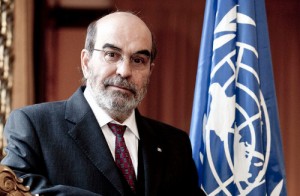José Graziano da Silva is Director-General of the Food and Agriculture Organization of the United Nations (FAO).
ROME, May 5 2016 (IPS) – After its remarkable success in reducing hunger, Europe must now rise to the challenge of making sure food assures more than survival and furnishes healthy lives. As head of a global hunger-fighting organization, nothing gives me more satisfaction than to see a vast region of the world achieving food security for its people.

José Graziano da Silva. Credit: FAO
With 53 member countries and one member organization, Europe and Central Asia is FAO’s largest region, stretching across 13 time zones from the Atlantic to the Pacific. Our data show that in almost every country, this region has succeeded in driving down food insecurity to below 5 percent of the population. The absolute number of hungry in the region has fallen by at least 40 percent since 1990.
Unfortunately, the story does not end here.
Malnutrition – as distinct from undernourishment (caloric insufficiency) – is a concern that cuts across the entire region. It takes many forms: micronutrient deficiencies, stunting, wasting, overweight and obesity. In fact, most countries in the region have alarming rates of obesity – more than 20 percent in adults. Malnutrition has health, social and economic costs that no society can afford to bear.
Why is this happening? Because just as countries emerge from the age-old problem of hunger, people’s diets and lifestyles are being influenced in negative ways by globalization, nutrition transition, and other changes.
Economic and social transformations – including higher incomes in many poor and middle-income nations, and the easy availability of over-processed foods at relatively cheap prices – are leading to changes in eating patterns that are driving up obesity rates. Other lifestyle changes, such as reduced physical activity, have made the situation even worse.
Ensuring access to adequate, nutritious and safe food for a growing population is one of the major challenges of our times. The problem is compounded as competition for scarce natural resources intensifies, and the adverse long-term effects of climate change are felt.
For Europe and Central Asia, the challenge now is to pass through this unhealthy interim stage as quickly as possible, into diets and eating habits that are diverse, nutritious, safe, and sustainable.
We took a firm step in the right direction with the Second International Conference on Nutrition in November 2014, when countries adopted the Rome Declaration on Nutrition and a framework for action on ending all forms of malnutrition. Countries committed to enhancing sustainable food systems by developing coherent policies from production to consumption and across all relevant sectors to provide year-round access to food that meets nutrition needs, and to promote safe and diversified healthy diets.
To succeed, countries will need to put the right policies in place to reform the food system, reduce food losses and waste, make it easier for consumers to make healthy food choices, empower people with nutrition education, provide accurate food labelling, promote cultivation of crops like pulses, develop small-scale, local agriculture, and connect those farmers with markets.
Next week, the countries of Europe and Central Asia will tackle the issue of unhealthy diets and other food- and agriculture-related issues when they convene in Antalya, Turkey for the 30th FAO Regional Conference for Europe. Ministers and other delegates and representatives of civil society and the private sector will discuss both problems and solutions and set priorities for FAO’s work across the region in the coming two-year period.
The societies of Europe and Central Asia today have the opportunity to choose a healthy future, and FAO is ready to support them in that choice.
(End)